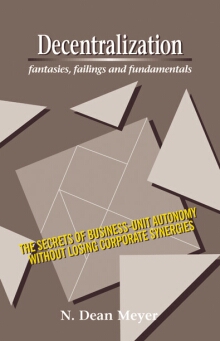| Excerpt from www.NDMA.COM, © 2025 N. Dean Meyer and Associates Inc.
Book:
Decentralization
fantasies, failings, and fundamentals
by N. Dean Meyer
Why decentralization is so expensive and harmful, why people advocate it, and how to get the benefits without paying the costs. Many people believe that decentralization is good for service functions such as engineering, manufacturing, sales, information systems, finance, human resources, and administration. They think decentralization will make staff more customer focused, improve their strategic alignment, and enhance business-unit autonomy. Sometimes it works. More often than not, results are disappointing. In either case, the costs of decentralization are extraordinarily high: Quality drops, innovation slows, responsiveness suffers, business synergies disappear, career paths are shattered, and expenses rise by as much as 50 percent. There must be a better way to make staff perform!
This book analyzes the reasons people decentralize, and why decentralization is so costly. It explains how a centralized shared-services department can be designed so that it delivers all the benefits of decentralization without any of the costs. And to help executives deal with past mistakes, it documents practical strategies for living with decentralization and for consolidating a fragmented function. This concise, logical analysis of the fundamentals of organizational design can be the basis for fact-based decision making about this often-emotional topic. Format: paperback, 147 pages. $8.95 US Table of Contents....
PREFACE — 1 INTRODUCTION 1. The Decentralization Controversy — 4 FANTASIES 2. Why Decentralization Is of Interest — 10 FAILINGS 3. Why Decentralization Is So Costly: Generalists — 18 4. Why Decentralization Is So Costly: Fragmentation — 29 5. The Bottom Line — 42 FUNDAMENTALS 6. The Vision: A Healthy Central Organization — 50 7. Customer Focus — 59 8. Strategic Alignment — 64 9. Business-unit Autonomy — 74 FIXES 10. How to Recentralize, Consolidate, or Merge — 86 11. How to Build a Healthy Business Within a Business — 98 PATCHES 12. If You Must Decentralize — 104
13. How to Live With Decentralization: — 114
14. How to Live With a Decentralized Consultancy — 125 PATH FORWARD 15. Conclusion: Leaders' Fundamental Choices — 138 INDEX — 141
Centralization vs. decentralization is one of the most common problems which occupy senior management, especially when cost-cutting measures or performance shortfalls from internal service providers are drivers. This book will clarify the key issues and provide decision makers with facts, clearly articulated reasons to either opt for centralization or make the best of decentralization if it's unavoidable. The author is clearly against decentralization and backs up the reasons why with short case studies and a compelling argument. Unlike other authors, though, Meyer is a realist and recognizes there will be circumstances that make decentralization inevitable, such as internal politics, larger initiatives placed in motion by executive management, and mergers. Instead of proclaiming total failure he provides organizational models and methods to make decentralization work as best it can. If you are evaluating the merits of decentralization vs. centralization of internal service functions Chapters 2 through 5 will arm you with a clear and objective view of the strengths and weaknesses. Chapters 6 through 9 are invaluable to decision makers in any corporate or business-unit reorganization because this material shows how to either design an organizational structure that is truly customer-focused, aligned strategically, and allows maintaining business-unit autonomy in a centralized environment. These draw from Meyer's other book, "The Internal Economy: How to Apply Market Principles within Organizations" (ISBN 1892606186), which nicely augments this book. Meyer also shows how to recentralize in Chapter 10, which also covers consolidation and merger. This is further fleshed out in Chapter 11, which proposes an innovative paradigm of a business within a business. If you are in an organization that either must decentralize, or is decentralized and the barriers to recentralization are too great, Chapters 12 through 14 will show you how to make the most of the situation. The various models and methods Meyer provide to accomplish this evidence his extensive experience and a lot of deep thought.
Overall this book is one of the best I've read on the subject. Indeed, the objectivity, combined with a bulletproof approach, has influenced me deeply.
Mike Tarrani
|




 Packed with wisdom and answers.
Packed with wisdom and answers.
